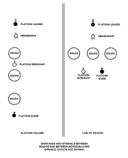
CHAPTER 5
RIFLE PLATOON
| Paragraphs | ||
|---|---|---|
| SECTION I. | General | 100-105 |
| II. | Attack | 106-110 |
| III. | Defense | 111-126 |
| IV. | Security missions | 127-132 |
SECTION I
GENERAL
- COMPOSITION.--A rifle platoon consists of a command group and three rifle squads. The command group consists of a platoon leader, a platoon sergeant, a platoon guide, messengers, and basic privates.
- DUTIES OF COMMAND GROUP.--
- The platoon leader is responsible for the training, discipline, control, and tactical employment of the platoon. It must be trained to accomplish its combat mission decisively and to function as an effective unit in the military team.
- The platoon sergeant is second-in-command. He assists the platoon leader in controlling the direction and rate of movement in the advance. During all operations he takes post as directed by the platoon leader so as best to assist in the control of the platoon. He replaces the platoon leader when the latter is not with the platoon or becomes a casualty.
- The platoon guide (a sergeant) prevents straggling and enforces orders concerning cover, concealment, and discipline. His position is usually in rear of the platoon, where he observes the situation on the flanks and rear. He checks ammunition expenditure and takes advantage of every opportunity to have ammunition replenished.
- When the company begins its development one messenger reports to the company commander and one remains with the platoon leader. (See par. 8b (8).)
- Basic privates are used as replacements.
- CONTROL AND COMMUNICATION.--The platoon leader controls the action of the platoon by oral orders or by arm-and-hand


